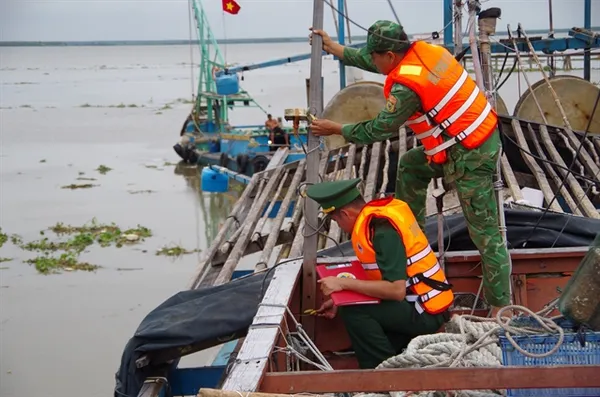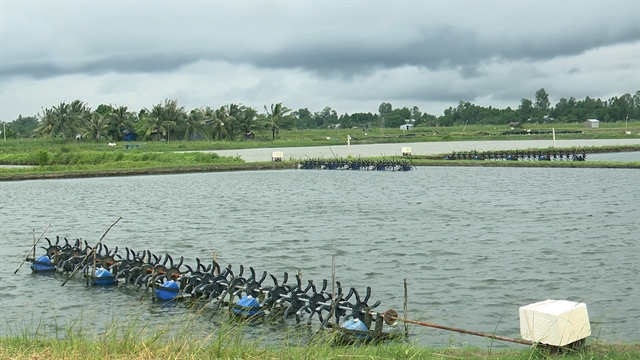 Society
Society

Farmers in the Cửu Long (Mekong) Delta province of Sóc Trăng have begun breeding shrimp, and hope for a yield of 196,000 tonnes this year, according to the local Fisheries Sub-department.

|
| Ponds for breeding brackish-water shrimp in Sóc Trăng Province’s Mỹ Xuyên District. — VNA/VNS Photo Chanh Đa |
SÓC TRĂNG — Farmers in the Cửu Long (Mekong) Delta province of Sóc Trăng have begun breeding shrimp, and hope for a yield of 196,000 tonnes this year, according to the local Fisheries Sub-department.
Of the 51,000ha they are farming, black tiger shrimp will account for 13,000ha and white-legged shrimp for 38,000ha.
The province has identified brackish – water shrimp, mostly the black tiger and white-legged varieties, as its key products.
Quách Thị Thanh Bình, deputy head of the sub-department, said the province has created schedules for releasing shrimp fry into ponds between January 10 and September 30 depending on local conditions and breeding methods.
Farmers who implement the shrimp-rice farming model in which they grow rice in the rainy season and breed shrimp in the dry season in the same fields have been instructed to complete the shrimp harvest before September, she said.
Households and establishments who have not secured enough water for shrimp farming should limit breeding in April amid the hot weather and saltwater intrusion and in June and July when there are prolonged rains, she said.
But companies and large farms capable of semi- intensive, intensive and two – stage shrimp farming could release shrimp fry into ponds for breeding all year round, she said.
Farmers have released shrimp fry into more than 900ha of ponds so far, according to the sub-department.
The Hoà Đê Agriculture and Aquaculture Co-operative in Mỹ Xuyên District’s Hoà Tú 1 Commune has more than 50 members who farm shrimp and rice on a total of 60ha.
Mã Văn Hồng, the director of the co-operative, said after harvesting the last rice crop the members began renovating their fields to prepare for the shrimp crop.
They dredged the fields, washed away salinity and acidity from the soil and sprayed lime to get rid of pathogens, he said.
The work is basically finished and the members are letting water into the fields and treating it for farming shrimp, he said.
The shrimp crop would begin in April, and the members expect to have a good one this year, he said.
Bình said the province would help shrimp farming households link up and set up co-operatives and co-operative groups to establish large-scale shrimp farming areas this year.
The co-operatives and co-operative groups would link up with shrimp processing companies with the latter providing inputs and steady outlets, she said.
The province will also develop linkages between authorities, farmers, companies, and associations to bolster efficiency.
It will develop shrimp farming based on Vietnamese and global good agricultural practices (GAP), Global Aquaculture Stewardship Council (ASC) and other international standards.
It will provide farmers information about market demand, breeding environment and diseases.
It will help them expand shrimp farming models, apply advanced techniques and protect the environment.
Top exporter
Sóc Trăng exported more than US$1 billion worth of shrimp products last year, up 23 per cent from 2020 and the country’s highest tally, according to its Department of Industry and Trade.
Võ Văn Chiêu, director of the department, said: “This is the second consecutive year in which Sóc Trăng leads the country in the export of shrimp.”
The province bred brackish water shrimp on 53,000ha last year and had an output of 189,000 tonnes, up 2.5 per cent in both area and output.
Shrimp bred using semi-intensive and intensive farming methods accounted for 93.7 per cent, according to the province Department of Agriculture and Rural Development.
Huỳnh Ngọc Nhã, director of the department, said the province had a good shrimp crop last year in terms of area, output and disease prevention.
“Several advanced farming models were expanded last year and they offered high economic efficiency.”
The province had more than 4,000ha of shrimp bred under intensive, super-intensive and hi-tech farming methods last year.
Lâm Thanh Phong, who owns a 3ha shrimp field in Vĩnh Châu Town’s Khánh Hoà Ward, has switched to covering his pond beds with plastic sheets and equipped the ponds with other modern facilities.
The weather was favourable last year and so his shrimp grew well, enabling him to harvest five tonnes per 1,300 sq.m pond per crop, he said.
“I often breed two to three crops a years and let them grow to the required large market sizes before selling them, thus increasing my income.”
The province has sustainably developed the shrimp – rice farming model as it adapts to climate change, helping farmers improve their incomes.
Sóc Trăng is one of the delta’s coastal provinces to adopt the model years ago since it is suitable for areas where rice fields are affected by saltwater intrusion.
The coastal district of Mỹ Xuyên thus has 10,000ha of shrimp-rice fields, the largest in the province.
Tô Minh Trí in Mỹ Xuyên’s Hoà Tú 1 Commune said he has implemented the shrimp-rice farming model for more than 20 years because it is effective and sustainable.
“The outputs of shrimp and rice are stable. The rice has high yields and high quality under the model.” — VNS




